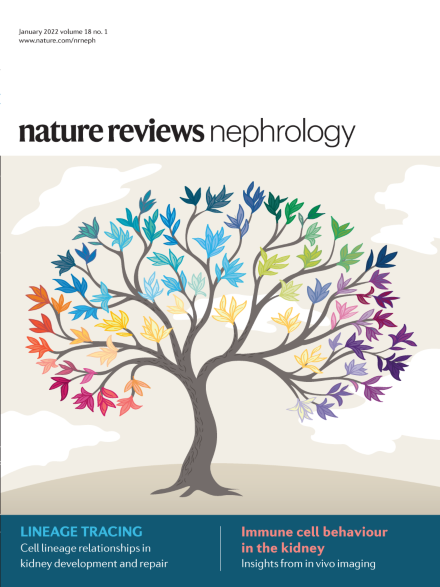Kidney health outcomes of hypertensive disorders of pregnancy
IF 39.8
1区 医学
Q1 UROLOGY & NEPHROLOGY
引用次数: 0
Abstract
Hypertensive disorders of pregnancy (HDPs), including pre-eclampsia (PE), are frequent, affecting 8–10% and 2–4% of all pregnancies, respectively. Among HDPs, PE is the best characterized and most frequently studied — it is a heterogeneous disease with different clinical phenotypes reflecting distinct underlying mechanisms that ultimately result in widespread endothelial dysfunction and systemic damage. HDP clinical remission is common after delivery, but the long-term health of women with a history of HDP is adversely affected compared with that of women with normotensive pregnancies. The relationship between HDP and kidney health is bidirectional: chronic kidney disease (CKD) increases the risk of HDP, and HDP raises the risk of future CKD. To what extent this increased risk of CKD after HDP is due to pre-existing CKD that is unmasked by pregnancy and/or whether HDP is a causal factor in CKD remains unclear. CKD is diagnosed in up to 20% of women after PE, and the lifetime risk of kidney failure after one episode of PE is 4–8 times higher than that of the general population, increasing further with PE recurrence. These risks are cross generational, as women born prematurely from pregnancies complicated by PE and fetal growth restriction can have low nephron mass, which would not only increase their lifetime risk of CKD but also their risk of developing PE in their own pregnancies. This Review examines the bidirectional relationship between hypertensive disorders of pregnancy and kidney disease, which is currently underrecognized, with potential long-term implications for kidney health in both mothers and their offspring. The authors also discuss prevention and management of hypertensive disorders of pregnancy, including kidney health follow-up, and current research gaps.


妊娠期高血压疾病对肾脏健康的影响
妊娠高血压疾病(HDPs),包括先兆子痫(PE),是常见的,分别影响所有妊娠的8-10%和2-4%。在HDPs中,PE是最具特征和最常被研究的疾病,它是一种异质性疾病,具有不同的临床表型,反映了不同的潜在机制,最终导致广泛的内皮功能障碍和全身损伤。分娩后HDP临床缓解是常见的,但与正常妊娠妇女相比,有HDP病史的妇女的长期健康受到不利影响。HDP与肾脏健康之间的关系是双向的:慢性肾脏疾病(CKD)增加HDP的风险,而HDP增加未来CKD的风险。在多大程度上,HDP后CKD的风险增加是由于妊娠暴露的已有CKD和/或HDP是否是CKD的一个因果因素尚不清楚。高达20%的女性在PE后被诊断为CKD,一次PE后肾衰竭的终生风险是一般人群的4-8倍,随着PE的复发进一步增加。这些风险是跨代的,因为妊娠合并PE和胎儿生长受限的早产妇女的肾单位质量可能较低,这不仅会增加她们一生中患CKD的风险,也会增加她们自己妊娠时患PE的风险。
本文章由计算机程序翻译,如有差异,请以英文原文为准。
求助全文
约1分钟内获得全文
求助全文
来源期刊

Nature Reviews Nephrology
医学-泌尿学与肾脏学
CiteScore
39.00
自引率
1.20%
发文量
127
审稿时长
6-12 weeks
期刊介绍:
Nature Reviews Nephrology aims to be the premier source of reviews and commentaries for the scientific communities it serves.
It strives to publish authoritative, accessible articles.
Articles are enhanced with clearly understandable figures, tables, and other display items.
Nature Reviews Nephrology publishes Research Highlights, News & Views, Comments, Reviews, Perspectives, and Consensus Statements.
The content is relevant to nephrologists and basic science researchers.
The broad scope of the journal ensures that the work reaches the widest possible audience.
 求助内容:
求助内容: 应助结果提醒方式:
应助结果提醒方式:


